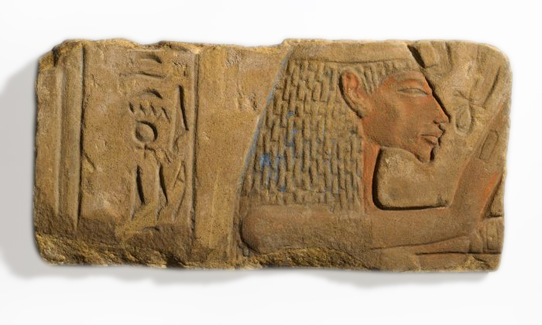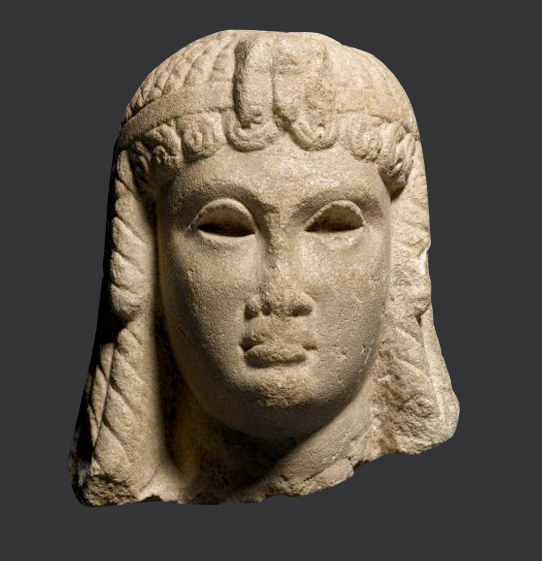
Head of Hatshepsut or Thutmose III. Egypt, provenance not known. New Kingdom, Dynasty 18, circa 1479–1425 B.C.E.
Granite. Brooklyn Museum, Charles Edwin Wilbour Fund, 55.118

Head of Hatshepsut or Thutmose III. Egypt, provenance not known. New Kingdom, Dynasty 18, circa 1479–1425 B.C.E.
Granite. Brooklyn Museum, Charles Edwin Wilbour Fund, 55.118

Queen Nefertiti. Egypt, Temple of Aten, Karnak (?). Early reign of Akhenaten, c. 1352–1348 B.C.E.
Sandstone. Brooklyn Museum, Gift of Christos G. Bastis, 78.39
Nefertiti was Akhenaten’s principal queen and mother of his six daughters. Her importance as a leading figure in the Amarna religious revolution (1352–1332 B.C.E.
) that taught a form of monotheism, is undisputed. Nefertiti here wears the Uraeus snake on her forehead and receives life from the hand of the god Aten, two attributes usually associated only with kings. When this work was complete, she stood at Akhenaten’s side as together they worshipped the Aten, their one god. Scholars dispute whether she ruled independently for three years after Akhenaten’s death. The date of her death is uncertain as is her relationship with Smenkare and Tutankhamun, the two succeeding kings. In spite of her successors attempts to eradicate her memory, today she is the most widely recognized of Egypt’s queens.

Ptolemaic Queen (Cleopatra VII ?). Egypt, provenance not known. Ptolemaic Period, 305–30 B.C.E.
Marble. Brooklyn Museum, Charles Edwin Wilbour Fund, 71.12
The last ruler of the Ptolemaic dynasty (332–30 B.C.E
), Cleopatra VII ruled from 51 to 31 B.C.E
and lived a complicated and eventful life as she attempted to maintain Egyptian independence from Rome. She shared the Egyptian throne at various times with her brothers and later tried to declare her son by Julius Caesar the king. Afterward she married Mark Anthony, Caesar’s heir. They had three children together. Defeated by Octavian (later the Emperor Augustus) at the Battle of Actium in 31 B.C.E. , Mark Anthony committed suicide and Cleopatra followed him eleven days later on August 12, 30 B.C.E. Of their three children, two were then raised in Rome and one married the king of Mauritania in present-day North Africa. The triple Uraeus on the queen’s brow identifies her to some scholars as Cleopatra VII. Though the Romans defamed her for political reasons, she remained a heroine in Egypt. Her political acumen allowed her to survive for over twenty years as she tried to steer Egypt on an independent course while the Roman empire grew and finally absorbed it.

Pharaohs, Queens, and Goddesses
February 3, 2007–February 3, 2008
This exhibition is the inaugural biographical gallery show of a series in the Elizabeth A. Sackler Center for Feminist Art. Presented in tandem with The Dinner Party by Judy Chicago, the exhibition is dedicated to powerful female pharaohs, queens, and goddesses from Egyptian history. The central object of the exhibition is an important granite head from the Brooklyn Museum collection of Hatshepsut, the fifth pharaoh of the Eighteenth Dynasty (1539–1292 B.C.E.), and one of the 39 women represented with a plate at The Dinner Party. Hatshepsut is featured alongside other women and goddesses from Egyptian history, including queens Cleopatra, Nefertiti, and Tiye and the goddesses Sakhmet, Mut, Neith, Wadjet, Bastet, Satis, and Nephthys—many of whom are featured on The Dinner Party‘s tiles. By incorporating multiple objects from the Museum’s extraordinary Egyptian collection, the exhibition encourages viewers to make visual and historical connections with the Museum’s long-term installation Egypt Reborn, which has additional objects on view pertaining to Pharaohs, Queens, and Goddesses.
This exhibition is co-curated by Maura Reilly, Ph.D., Curator of the Elizabeth A. Sackler Center for Feminist Art, Brooklyn Museum, and Edward Bleiberg, Curator of Egyptian, Classical, and Ancient Middle Eastern Art, Brooklyn Museum.
